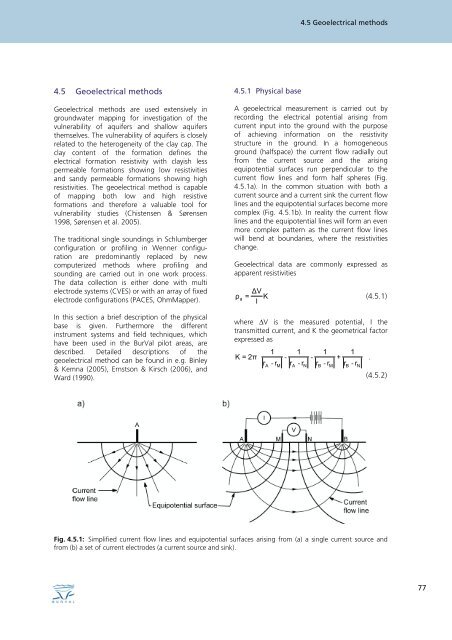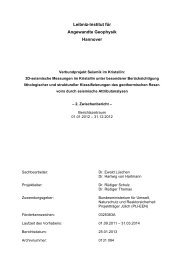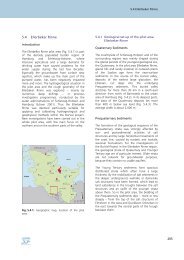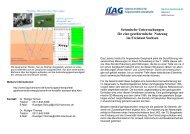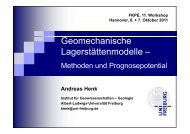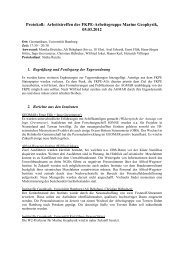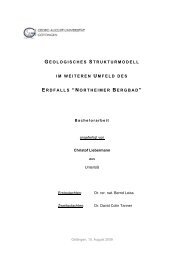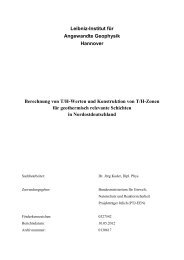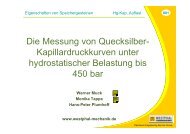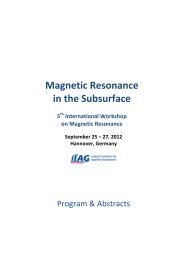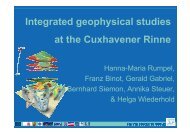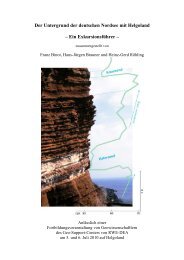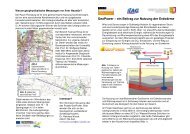4.5 Geoelectrical methods - LIAG
4.5 Geoelectrical methods - LIAG
4.5 Geoelectrical methods - LIAG
You also want an ePaper? Increase the reach of your titles
YUMPU automatically turns print PDFs into web optimized ePapers that Google loves.
<strong>4.5</strong> <strong>Geoelectrical</strong> <strong>methods</strong><br />
<strong>Geoelectrical</strong> <strong>methods</strong> are used extensively in<br />
groundwater mapping for investigation of the<br />
vulnerability of aquifers and shallow aquifers<br />
themselves. The vulnerability of aquifers is closely<br />
related to the heterogeneity of the clay cap. The<br />
clay content of the formation defines the<br />
electrical formation resistivity with clayish less<br />
permeable formations showing low resistivities<br />
and sandy permeable formations showing high<br />
resistivities. The geoelectrical method is capable<br />
of mapping both low and high resistive<br />
formations and therefore a valuable tool for<br />
vulnerability studies (Chistensen & Sørensen<br />
1998, Sørensen et al. 2005).<br />
The traditional single soundings in Schlumberger<br />
configuration or profiling in Wenner configuration<br />
are predominantly replaced by new<br />
computerized <strong>methods</strong> where profiling and<br />
sounding are carried out in one work process.<br />
The data collection is either done with multi<br />
electrode systems (CVES) or with an array of fixed<br />
electrode configurations (PACES, OhmMapper).<br />
In this section a brief description of the physical<br />
base is given. Furthermore the different<br />
instrument systems and field techniques, which<br />
have been used in the BurVal pilot areas, are<br />
described. Detailed descriptions of the<br />
geoelectrical method can be found in e.g. Binley<br />
& Kemna (2005), Ernstson & Kirsch (2006), and<br />
Ward (1990).<br />
<strong>4.5</strong>.1 Physical base<br />
<strong>4.5</strong> <strong>Geoelectrical</strong> <strong>methods</strong><br />
A geoelectrical measurement is carried out by<br />
recording the electrical potential arising from<br />
current input into the ground with the purpose<br />
of achieving information on the resistivity<br />
structure in the ground. In a homogeneous<br />
ground (halfspace) the current flow radially out<br />
from the current source and the arising<br />
equipotential surfaces run perpendicular to the<br />
current flow lines and form half spheres (Fig.<br />
<strong>4.5</strong>.1a). In the common situation with both a<br />
current source and a current sink the current flow<br />
lines and the equipotential surfaces become more<br />
complex (Fig. <strong>4.5</strong>.1b). In reality the current flow<br />
lines and the equipotential lines will form an even<br />
more complex pattern as the current flow lines<br />
will bend at boundaries, where the resistivities<br />
change.<br />
<strong>Geoelectrical</strong> data are commonly expressed as<br />
apparent resistivities<br />
ΔV<br />
= K<br />
I<br />
ρ a (<strong>4.5</strong>.1)<br />
where ΔV is the measured potential, I the<br />
transmitted current, and K the geometrical factor<br />
expressed as<br />
K = 2π<br />
r<br />
A<br />
1<br />
- r<br />
M<br />
1 1 1<br />
- - +<br />
r - r r - r r - r<br />
A<br />
N<br />
B<br />
M<br />
B<br />
N<br />
.<br />
(<strong>4.5</strong>.2)<br />
Fig. <strong>4.5</strong>.1: Simplified current flow lines and equipotential surfaces arising from (a) a single current source and<br />
from (b) a set of current electrodes (a current source and sink).<br />
77
78<br />
INGELISE MØLLER, KURT I. SØRENSEN & ESBEN AUKEN<br />
The apparent resistivity is defined so that it is<br />
equal to the true resistivity in a homogeneous<br />
halfspace. In Equation <strong>4.5</strong>.2 r A and r B are positions<br />
of the current electrodes and r M and r N are<br />
positions of the potential electrodes (Fig. <strong>4.5</strong>.1).<br />
Some of the most common electrode arrays are<br />
Wenner, Schlumberger, pole-pole, pole-dipole<br />
and dipole-dipole array (Fig. <strong>4.5</strong>.2). Recently, the<br />
gradient array (Fig. <strong>4.5</strong>.2) has gained renewed<br />
interest, since it is well suited for multichannel<br />
systems. Dahlin & Zhou (2004) have investigated<br />
the resolution capacity and efficiency of 10<br />
electrode arrays in a numerical modelling study.<br />
They find that the dipole-dipole, pole-dipole and<br />
the gradient arrays have the best resolution.<br />
However these arrays are most sensible to noise,<br />
whereas the often used Wenner array and the<br />
gamma array are less sensible to noise. Despite<br />
the sensibility to noise, they recommend for 2D<br />
resistivity surveying collected with a high data<br />
density, the gradient, pole-dipole and dipoledipole<br />
arrays as well as Schlumberger array,<br />
because of the resolution capacity.<br />
<strong>4.5</strong>.2 Field techniques<br />
In the following section three field techniques are<br />
described: the vertical electrical sounding, the<br />
continuous vertical electrical sounding and the<br />
pulled array continuous electrical sounding<br />
<strong>methods</strong>.<br />
Fig. <strong>4.5</strong>.2: Some of the most common used electrode configurations. The letters A and B denote the current<br />
electrodes and the letters M and N denote the potential electrodes.
Fig. <strong>4.5</strong>.3: Sketch of the field setup for a VES in Schlumberger configuration.<br />
Vertical electrical sounding<br />
Vertical electrical sounding, VES, is used to<br />
determine the resistivity variation with depth.<br />
Single VES should only be applied in areas, where<br />
the ground is assumed to be horizontal layered<br />
with very little lateral variation, since the<br />
sounding curves only can be interpreted using a<br />
horizontally layered earth (1D) model. A short<br />
description of the field technique is given here. A<br />
more comprehensive description can be found in,<br />
e.g., Ernstson & Kirsch (2006).<br />
A VES is typically carried out in Schlumberger<br />
array, where the potential electrodes are placed<br />
in a fixed position with a short separation and the<br />
current electrodes are placed symmetrically on<br />
the outer sides of the potential electrodes (Fig.<br />
<strong>4.5</strong>.3). After each resistivity measurement the<br />
current electrodes are moved further away from<br />
the centre of the array. In this way the current is<br />
stepwise made to flow through deeper and<br />
deeper parts of the ground. The positions of the<br />
current electrodes are typically logarithmically<br />
distributed with at least 10 positions per decade.<br />
For large distances between the current<br />
electrodes, the distance of the potential<br />
electrodes is increased to ensure that the<br />
measured voltage is above the noise level and the<br />
detection level in the instrument.<br />
For a VES in Schlumberger array, the distance<br />
between the current electrodes should be about<br />
250 m to detect a resistivity layer boundary in the<br />
depth of 50 m.<br />
<strong>4.5</strong> <strong>Geoelectrical</strong> <strong>methods</strong><br />
Continuous Vertical Electrical Sounding<br />
Continuous vertical electrical sounding, CVES,<br />
combines profiling and sounding, so that a 2D<br />
data coverage along a profile is obtained. This<br />
results in an image of the resistivity structure<br />
along a profile. The development of the CVES<br />
method has taken place since the 1980’ies (e.g.,<br />
van Overmeeren & Ritsema 1988; Dahlin 1996).<br />
A large number of electrodes are places on a line<br />
at equal distance and connected to a switching<br />
unit and the resistivity instrument by multicore<br />
cables (Fig. <strong>4.5</strong>.4). One multicore cable has about<br />
20 electrode take-outs and up to three to four<br />
cables are used for one electrode setup. Long<br />
profiles are carried out using roll-along<br />
technique, where the last cable successively is<br />
moved to the front of the profile and connected<br />
to the first cable (Dahlin 1996). A computer,<br />
which typically is build into modern resistivity<br />
instrument, controls which electrodes are used as<br />
current and potential electrodes.<br />
Multichannel resistivity instruments become more<br />
and more used in stead of single channel<br />
resistivity meters. Data collection in Wenner<br />
arrays has been preferred when using single<br />
channel resistivity meters because of the Wenner<br />
arrays robustness against noise. When<br />
multichannel instruments are used other<br />
electrode arrays are more efficient. More noise<br />
sensible arrays are acceptable to use, when the<br />
data are collected with a high data density.<br />
Dahlin & Zhou (2004) recommend for instants<br />
the moving gradient array for multichannel<br />
instruments.<br />
79
80<br />
INGELISE MØLLER, KURT I. SØRENSEN & ESBEN AUKEN<br />
Fig. <strong>4.5</strong>.4: The CVES method. a) A sketch of a field setup for CVES and data density for a profile acquired in<br />
Wenner configuration with 5 electrode spacings. b) Photo of the CVES system in the field.<br />
The productivity in the field depends on the<br />
density of the data points in the profiles and the<br />
number of channels in the resistivity instrument.<br />
The initial electrode spacing do also count,<br />
because the longer electrode spacing the longer<br />
distances the field crew have to walk, while they<br />
roll cables out, enter electrodes into the ground,<br />
and connect them to the cables.<br />
In groundwater mapping an initial electrode<br />
spacing of 5 m is very common. When the data<br />
are collected in Wenner arrays the maximum<br />
electrode spacing is thus typically about 100–120<br />
m with a total array length of 300–360 m. This<br />
leads to a penetration depth about 60–80 m.<br />
Other types of electrode arrays with similar<br />
maximum array lengths result in similar<br />
penetration depths. If the target is shallower, the<br />
initial electrode spacing can be decreased. This<br />
will also result in a higher resolution of particular<br />
the near surface small-scale resistivity structures.<br />
Pulled array continuous electrical sounding<br />
The PACES system was developed to meet the<br />
demands of high productivity, reliability and<br />
detailed, dense sampling (Sørensen 1996,<br />
Sørensen et al. 2005). Figure <strong>4.5</strong>.5 shows<br />
schematics and photograph of the system. A<br />
small caterpillar pulls a tail of electrodes along<br />
with the processing electronics. The caterpillar,<br />
with a height of 80 cm and a width of 70 cm can<br />
pass under fences and in between trees. A small<br />
3 m platform is carried along and serves as a<br />
bridge for crossing small creeks and ditches. Eight<br />
electrode arrays are measured simultaneously<br />
allowing for sounding data to be acquired<br />
continuously along the profile (Fig. <strong>4.5</strong>.5b). A<br />
crew of two workers can record profile lengths of<br />
10–20 km/day.<br />
Two electrodes with a current of 2–30<br />
milliamperes are maintained as sources. The<br />
current limit of 30 milliamperes is for the safety<br />
of personnel. The current is maintained at a<br />
constant level with a current generator in order<br />
to facilitate data processing.<br />
Processing electronics with a high input<br />
resistance of 5-10 Megaohms (MΩ) are mounted<br />
inside the potential electrodes to diminish earth<br />
contact problems, cross talk and capacitive<br />
coupling between receiver– and transmitter<br />
cabling in the tail. Light weighted mild-steel<br />
electrodes with a maximum of 10 kg are<br />
necessary as current and potential electrodes.<br />
Electrochemical interactions between the rapidly<br />
changing soil environment and metal potential<br />
electrodes are by far the largest noise sources.<br />
The decay time of these noise potentials is of the<br />
order of seconds. Clearly this is not an issue<br />
when using traditional metal rods, but in the case
<strong>4.5</strong> <strong>Geoelectrical</strong> <strong>methods</strong><br />
Fig. <strong>4.5</strong>.5: The PACES method. a) Sketch of the PACES system, where a tail of electrodes is pulled by a small<br />
caterpillar. b) A diagram of the eight electrode configurations, which all use the same two current electrodes. c)<br />
Photo of the PACES system in the field.<br />
of moving electrodes the influence may be<br />
severe. The electrochemical noise is suppressed<br />
by applying synchronous detection techniques<br />
with a frequency of 20 Hz followed by adapted<br />
filtering (Munkholm et al. 1995).<br />
Digital data acquisition is performed on-line by<br />
equipment on the caterpillar. The data are<br />
sampled with a frequency of 80 Hz and reduced<br />
to a dataset for every second, and the speed of<br />
the tail is approximately 1 m/s (3 km/h). The<br />
spatial averaging width in the post-processing<br />
stage is related to the electrode spacing and is<br />
usually 0.1 – 0.25 times the spacing, giving a<br />
detailed spatial resolution and smooth datasets.<br />
To monitor data quality, the system has the<br />
ability to detect insufficient galvanic contact at<br />
the current and potential electrodes while<br />
measuring. In addition, the magnitude of the<br />
emitted current is adapted automatically to<br />
ground contact to optimize the signal-to-noise<br />
ratio. The amplification in each channel adjusts<br />
automatically to the level of the incoming signals<br />
(Sørensen 1996). All parameters related to the<br />
measuring process are stored together with the<br />
data sets to insure high data quality.<br />
<strong>4.5</strong>.3 Data processing and inversion<br />
Data processing<br />
<strong>Geoelectrical</strong> data are normally processed by<br />
simply removing data influenced by noise. Figure<br />
<strong>4.5</strong>.6a shows an example of a data profile<br />
collected using gradient arrays (Dahlin & Zhou<br />
2004). A very simple data processing is done to<br />
the data and only data with a “jiggered”<br />
appearance are removed. The removal is done<br />
manual. The pseudosection in Figure <strong>4.5</strong>.6b<br />
shows colour contour of the same data as in<br />
Figure <strong>4.5</strong>.6a.<br />
Inversion<br />
In the following we will discuss inversion methodologies<br />
for CVES and PACES data focusing on the<br />
1-D and the 2D laterally constrained inversion<br />
(LCI) which uses sharp layer boundaries.<br />
The 1D-LCI was originally developed for inverting<br />
PACES data (Sørensen 1996). The data quantities<br />
from the PACES system are extremely large, and<br />
2D smooth inversion is therefore not practically<br />
possible on a routine basis. Because the PACES<br />
81
82<br />
INGELISE MØLLER, KURT I. SØRENSEN & ESBEN AUKEN<br />
Fig. <strong>4.5</strong>.6: CVES data collected in gradient arrays are shown (a) as curves for each individual array and (b) as a<br />
data pseudo section. Hot colours indicate high resistivities while green and blue colours indicate low resistivities.<br />
system is used in sedimentary environments with<br />
relatively smooth lateral resistivity variations, a<br />
layered inversion model is desirable.<br />
The 1D-LCI solves a number of 1D problems<br />
simultaneously with constraints between<br />
neighbouring models (Auken et al. 2005). This<br />
requires that all separate 1D models have the<br />
same subset of model parameters. The 1D-LCI<br />
approach is illustrated in Figure <strong>4.5</strong>.7. The CVES<br />
dataset in Figure <strong>4.5</strong>.7a is divided into soundings<br />
and models. All models and corresponding<br />
datasets are inverted simultaneously, minimizing<br />
a common object function (Auken & Christiansen<br />
2004). The lateral constraints and constraints<br />
from a priori information are all part of the data<br />
vector together with the apparent resistivity data.<br />
Due to the lateral constraints, information from<br />
one model will spread to neighbour models. If<br />
the model parameters of a specific model are<br />
better resolved, due to, e.g., a priori information,<br />
this information will also spread to neighbour<br />
models.<br />
The lateral constraints can be considered as a<br />
priori information on the geological variability<br />
within the area, where the measurements are<br />
taken. The smaller the expected variation for a<br />
model parameter is, the harder the constraint.<br />
A priori information can be added to the dataset<br />
as depth to layers or layer resistivities. The<br />
information originates from auger– and coredrillings<br />
or geophysical well logs. If the a priori<br />
data agree with the resistivity data, the depth to<br />
layers in the resistivity model will coincide with
<strong>4.5</strong> <strong>Geoelectrical</strong> <strong>methods</strong><br />
Fig. <strong>4.5</strong>.7: a) The CVES profile is divided into n datasets. b) The datasets are inverted simultaneously with a 1D<br />
model resulting in a pseudo-2D image. The models are constrained laterally, and each model allows a priori<br />
constraints on the resistivities and thicknesses or depths. After Wisén et al. (2005).<br />
the a priori data. If, on the other hand, enough<br />
resistivity data suggest a different depth than the<br />
a priori data, the layer boundary in the resistivity<br />
model will most likely not agree with the a priori<br />
data.<br />
The 2D LCI algorithm (Auken & Christiansen<br />
2004) uses the same formulation of the inversion<br />
scheme as the 1D LCI. The difference is that the<br />
forward model is 2D and not 1D. This means that<br />
the 2D formulation can handle large lateral<br />
variations in the subsurface resistivity, variations<br />
causing the 1D formulation to output sections<br />
with 2D artefacts.<br />
A very common way of inverting CVES data is to<br />
use a 2D smooth inversion as presented by, e.g.,<br />
Loke & Dahlin (2002) and Oldenburg & Li (1994).<br />
In the 2D smooth inversion the model is divided<br />
into cells and the inversion claims to some extent<br />
equality between neighbouring cells. The object<br />
function reduces a combination of data misfit<br />
and structure of the model to obtain a smooth<br />
model. This is the same as saying that the user<br />
picks a misfit and then the algorithm reduces<br />
structure of the model and data misfit to reach<br />
that misfit.<br />
Figure <strong>4.5</strong>.8 shows the interpretation of a 300 m<br />
CVES profile from the southern part of Sweden.<br />
The resistivity survey was carried out as part of<br />
the geotechnical investigations for road<br />
construction in connection with the motorway<br />
connections to the Öresund bridge-tunnel<br />
between Denmark and Sweden.<br />
The data pseudo section in Figure <strong>4.5</strong>.8a presents<br />
relatively smooth transitions and there are no<br />
clear signs of characteristic 2D structures,<br />
although near surface resistivity variations can be<br />
recognized at, e.g., profile coordinate 14.05 km.<br />
The minimum structure 2D inversion (Oldenburg<br />
& Li 1994) in Figure <strong>4.5</strong>.8b detects a number of<br />
near-surface inhomogeneities along the profile.<br />
83
84<br />
INGELISE MØLLER, KURT I. SØRENSEN & ESBEN AUKEN<br />
Fig. <strong>4.5</strong>.8: CVES field data. a) Data presented as a data pseudo section. b) Minimum structure 2D inversion. c)<br />
Stitched-together section of 1D inversion with analyses in (d). e) LCI section with analyses in (f). The colour-coding<br />
of the analyses ranges from well-resolved (red) to poorly resolved (blue). Two drill holes are located at 14.1 km<br />
and 14.2 km. The colours from the hole located at 14.2 km indicate from the bottom: grey medium fine clay<br />
(grey), silty sand (dark yellow), brown medium fine clay (brown) and medium sands at the top (yellow). In the drill<br />
hole at 14.2 km the silty layer is missing, otherwise they are the same. After Auken et al. (2005).<br />
Up to a depth of approximately 10 m, there<br />
seems to be a relatively horizontal layer with<br />
resistivities about 40 Ωm above a more resistive<br />
basement. Formation boundaries cannot be<br />
recognized from the inverted section. Figure<br />
<strong>4.5</strong>.8c presents a section of stitched-together 1D<br />
inversions along the profile. Indications of<br />
formation boundaries are seen, but they have a<br />
geologically unrealistic appearance mainly<br />
because of equivalence problems. The analyses<br />
(Fig. <strong>4.5</strong>.8d) present poorly resolved parameters<br />
with only occasionally well determined<br />
parameters. The LCI model section (Fig. <strong>4.5</strong>.8e)<br />
presents a model using 4 layers with smooth<br />
transitions in resistivities and layer boundaries,<br />
while still picking up the near-surface resistivity<br />
changes. The constraints between resistivities and<br />
depth interfaces used in the LCI inversion form a<br />
factor of 1.14. Now we can see a layered<br />
structure with a bowl-shape on the bottom layer<br />
along the profile, and we are able to differentiate<br />
between the two clay layers depicted in the drill<br />
holes. The thicknesses of the top layer and the<br />
brown clay layer are consistent with those found<br />
in the two drill holes. The silty layer is not found,<br />
either because it is a very local structure, as<br />
indicated by the drill holes, because the resistivity<br />
of the layer is close to that of the clay layers, or<br />
because the layer is too thin. The analyses (Fig.<br />
<strong>4.5</strong>.8f) present mainly well determined<br />
parameters along the profile. Only the thickness<br />
of the second layer is rather poorly determined<br />
due to the low resistivity contrast to the third<br />
layer. All the model sections presented produce<br />
data that fit the observed data to an acceptable<br />
level.
<strong>4.5</strong>.4 Penetration depth<br />
The penetration depth depends on the chosen<br />
electrode array, maximum electrode spacing and<br />
the data density. Furthermore the resistivity<br />
structure in the ground and the contrast of the<br />
resistivity structures influence on the penetration<br />
depth. A conductive layer close to terrain tends<br />
to decrease the penetration depth since the<br />
current primarily would flow in the conductive<br />
layer. If a resistive layer overlies a conductive layer<br />
the penetration depth may increase as the<br />
current tends to flow in the deeper conductive<br />
layer.<br />
In an area with glacial deposits like in Denmark,<br />
northern Germany and parts of The Netherlands<br />
the geological variability is relatively large, thus it<br />
is very helpful to introduce the term “robust<br />
penetration depth”. When you talk about robust<br />
penetration depth the dimension in the data is<br />
taken into account. A CVES dataset is collected<br />
along a profile and interpreted using a 2D<br />
resistivity model, though the geological setting<br />
and the thereby resistivity structure varies in three<br />
dimensions. At large electrode spacings in a CVES<br />
profile the volume of the ground also<br />
perpendicular to the array and profile direction<br />
becomes so large that resistivity variations also<br />
perpendicular to the profile start to influence in<br />
the measurements. In Denmark the experience is<br />
that for a CVES profile the robust penetration<br />
depth is about 60 m. Likewise a VES maps the<br />
resistivity variation with depth at one point and is<br />
interpreted using a 1D resistivity model thus the<br />
resistivity structure may vary in three dimensions.<br />
For a VES it is even more critical if there are<br />
resistivity variations in the direction of the<br />
electrode array.<br />
<strong>4.5</strong>.5 Resolution<br />
It is difficult to give quantitative measures for the<br />
resolution. It depends on the number and the<br />
type of electrode arrays used, the resistivity<br />
structures and the resistivity contrast of the<br />
resistivity structures. Numerical studies for 1D<br />
models can be carried out in a systematic way<br />
(e.g., Christensen & Sørensen 2001). There are<br />
only a few examples on studies of the resolution<br />
of 2D models. Dahlin & Zhou (2004) show how<br />
different electrode arrays resolve five different 2D<br />
<strong>4.5</strong> <strong>Geoelectrical</strong> <strong>methods</strong><br />
models. From these results it is clearly seen that<br />
the resolution decreases both vertically and<br />
laterally by depth.<br />
By a rule of thump a horizontal resistivity<br />
structure should have a thickness of about 1.5–2<br />
times the layers above it to be well determined in<br />
a resistivity model. Thinner resistivity structures<br />
may be seen in the data and indication of the<br />
structure will appear in the resistivity model.<br />
Resistivity structures thinner than 1.5–2 times the<br />
layers above it may suffer from equivalences (see<br />
Sect. <strong>4.5</strong>.6.).<br />
<strong>4.5</strong>.6 Restrictions, uncertainties, error<br />
sources and pitfalls<br />
Restrictions in penetration depth with lowvoltage<br />
equipment<br />
The small low-voltage resistivity meters, which<br />
usually are used in groundwater surveys, would<br />
normally be applicable for mapping in the upper<br />
100 m. If deeper penetration is wanted, very<br />
large electrode spacings must be used, which<br />
require high voltage for generating enough<br />
current to arise a detectable potential difference.<br />
This means that heavier equipment including<br />
strong generators is needed for the fieldwork. In<br />
the planning of a geoelectrical survey with deep<br />
penetration depth, it is important to judge if the<br />
geological setting is suited for 1D or 2D data<br />
collection (see Sect. <strong>4.5</strong>.4 Penetration depth).<br />
Principle of equivalence<br />
The “principle of equivalence” is a serious<br />
problem for geoelectrical data. Equivalences<br />
occur, where a resistive layer lies in between two<br />
conductive layers or vice versa. If a relatively thin<br />
resistive layer lies in between two conductive<br />
layers, it may only be possible to determine the<br />
resistance of the layer, i.e., the product of the<br />
resistivity and the thickness. Therefore, a resistive<br />
layer and a layer with the half thickness and the<br />
double resistivity give very equal responses.<br />
Resistive layers should have a thickness more<br />
than 1.5–2 times the layers above it before the<br />
resistivity and the thickness of the layer can be<br />
resolved independently.<br />
85
86<br />
INGELISE MØLLER, KURT I. SØRENSEN & ESBEN AUKEN<br />
In the opposite case, where a conductive layer<br />
lies in between two resistive layers, it may only be<br />
possible to determine the conductance of the<br />
layer, i.e., the thickness divided by the resistivity.<br />
Therefore a conductive layer and a layer with the<br />
double resistivity and double thickness give very<br />
equal responses. The conductive layer also has to<br />
be about 1.5–2 times as thick as the layers in<br />
total above it to be determined by both its<br />
thickness and resistivity separately.<br />
In the interpretation of geoelectrical data it is<br />
important to take the possibility of equivalence<br />
into account since equivalent models may lead to<br />
quite different hydrogeological models. If we<br />
have a sand and gravel layer of high resistivity in<br />
between two clay layer of low resistivity that<br />
suffers from equivalence, the high resistive layer<br />
may either be interpreted as a thin layer of<br />
unsaturated sand and gravel or the thicker layer<br />
of saturated sand and gravel.<br />
Electromagnetic noise and other cultural<br />
noise sources<br />
<strong>Geoelectrical</strong> measurements are in general robust<br />
towards electromagnetic noise. Although one<br />
should avoid locating profiles parallel to highvoltage<br />
power lines. A safety distance of about<br />
1.5 to 2 times the expected penetration depth<br />
should ensure a good data quality.<br />
Elongated resistivity anomalies that are parallel to<br />
2D resistivity profiles may distort the data. If a 2D<br />
resistivity profile is placed parallel to an elongated<br />
good conductor like a metallic fence with<br />
galvanic contact to the ground, buried metal<br />
pipes or cables with a metallic casing, current can<br />
be channelled through the good conductor. It<br />
should also be avoided to place the profiles<br />
parallel to other elongated resistivity anomalies<br />
like road beds, dykes, ditches and streams<br />
because the symmetry of the current density<br />
parallel to the profile is distorted. A safety<br />
distance of about 1.5 to 2 times the expected<br />
penetration depth should also here ensure a<br />
good data quality.<br />
2D resistivity profiles that cross cultural resistivity<br />
anomalies perpendicular cause no problem. A<br />
thin metal pipe may even not cover a large<br />
enough area to be detected.<br />
Season of field work<br />
The best and less noisy data are collected if a<br />
good contact to the ground is present. A good<br />
ground contact results in a relative low contact<br />
resistance between the electrodes and the<br />
ground, which ensure that relative high current<br />
can be suppressed into the ground. Good contact<br />
between the electrodes and the ground is<br />
obtained, when the soil is moist and at least<br />
partly saturated by water. It can be difficult to<br />
obtain a good data quality or even to collect<br />
data, if the soil at ground surface is completely<br />
dry. In an area with dry soil, the data quality can<br />
be enhanced, if the soil around the electrodes are<br />
watered by salty water, thus it is labour-intensive.<br />
In agricultural areas the field work may be<br />
restricted to seasons of the year, where no crop is<br />
in the field or the plants still are small.<br />
<strong>4.5</strong>.7 References<br />
Auken E, Christiansen AV (2004): Layered and<br />
laterally constrained 2D inversion of resistivity<br />
data. – Geophysics 69: 752–761.<br />
Auken E, Christiansen AV, Jacobsen BH, Foged N,<br />
and Sørensen KI (2005): Piecewise 1D<br />
Laterally Constrained Inversion of resistivity<br />
data. – Geophysical Prospecting 53: 497–506.<br />
Binley A, Kemna A (2005): DC resistivity and<br />
induced polarization <strong>methods</strong>. – In Yuram R,<br />
Hubbard SS (eds.): Hydrogeophysics. Water<br />
and Science Technology Library 50: 129–156.<br />
Springer, New York.<br />
Christensen NB, Sørensen KI (1998): Surface and<br />
borehole electric and electromagnetic<br />
<strong>methods</strong> for hydrogeological investigations. –<br />
European Journal of Environmental and<br />
Engineering Geophysics 3: 75–90.<br />
Christensen NB, Sørensen K (2001): Pulled array<br />
continuous electrical sounding with an<br />
additional inductive source: an experimental<br />
design study. – Geophysical Prospecting 49:<br />
241–254.<br />
Dahlin T (1996): 2D resistivity surveying for<br />
environmental and engineering applications. –<br />
First Break 14: 275–283.
Dahlin T, Zhou B (2004): A numerical comparison<br />
of 2D resistivity imaging with 10 electrode<br />
arrays. – Geophysical Prospecting 52: 379–<br />
398.<br />
Ernstson K, Kirsch R (2006): <strong>Geoelectrical</strong><br />
<strong>methods</strong>, basic principles. – In Kirsch R (ed):<br />
Groundwater Geophysics: A Tool for<br />
Hydrology, 85–108. Springer.<br />
Loke MH, Dahlin T (2002): A comparison of the<br />
Gauss-Newton and quasi-Newton <strong>methods</strong> in<br />
resistivity imaging inversion. – Journal of<br />
Applied Geophysics 49: 149–162.<br />
Munkholm MS, Sørensen KI, Jacobsen BH (1995):<br />
Characterization and in-field suppression of<br />
noise in Hydrogeophysics. – In: Proceedings of<br />
the Symposium on the Application of<br />
Geophysics to Engineering and Environmental<br />
Problems (SAGEEP), Orlando, Florida: 339–<br />
348.<br />
Oldenburg DW, Li Y (1994): Inversion of induced<br />
polarization data. – Geophysics 59: 1327–<br />
1341.<br />
<strong>4.5</strong> <strong>Geoelectrical</strong> <strong>methods</strong><br />
Sørensen KI, Auken E, Christensen NB, Pellerin L<br />
(2005): An Integrated Approach for<br />
Hydrogeophysical Investigations: New<br />
Technologies and a Case History. – In Butler D<br />
K (ed.) Near-Surface Geophysics 2,<br />
Investigations in Geophysics 13: 585–603.<br />
Society of Exploration Geophysics.<br />
Sørensen KI (1996): Pulled Array Continuous<br />
Electrical Profiling. – First Break 14: 85–90.<br />
van Overmeeren RA, Ritsema IL (1988):<br />
Continouos vertical electrical sounding. – First<br />
Break 6: 313–324.<br />
Ward SH (1990): Resistivity and induced<br />
polarization <strong>methods</strong>. – In Ward SH (ed.):<br />
Geotechnical and Environmental Geophysics<br />
1, Investigations in Geophysics 5: 147–189.<br />
Society of Exploration Geophysics.<br />
Wisén R, Auken E, Dahlin T (2005): Combination<br />
of 1D laterally constrained inversion and 2D<br />
smooth inversion of resistivity data with a<br />
priori data from boreholes. – Near Surface<br />
Geophysics 3: 71–79.<br />
87
88<br />
INGELISE MØLLER, KURT I. SØRENSEN & ESBEN AUKEN


